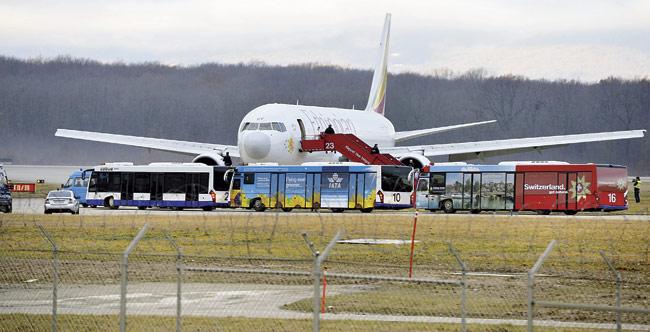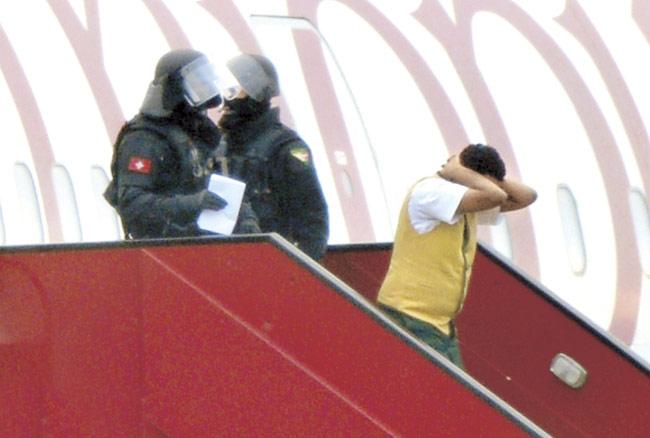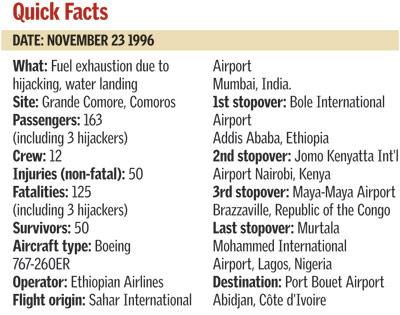Yesterday, an Ethiopian Airlines flight was hijacked by the co-pilot and flown to Geneva Switzerland, instead of its original destination Rome. There were no injuries or fatalities on board the aircraft. In 1996 though passengers on a Ethiopian Airlines flight were not so fortunate. 125 of them perished in a hijacking on a flight that originated from Mumbai... read on for the rest of that story

Yesterday, an Ethiopian Airlines flight scheduled to fly to Rome, was hijacked by the co-pilot who wanted political asylum. He took the aircraft to Geneva where he landed and was taken into police custody. No passenger was harmed or died in this hijacking.
ADVERTISEMENT

Passengers exited the Ethiopian Airlines plane at Geneva, shaken but unhurt, holding their arms behind their heads. Pic/AFP
Yesterday's incident takes us back to 1996, when Ethiopian Airlines Flight 961, a Boeing 767-200ER, was hijacked on November 23 1996. The Wikipedia states that the flight was enroute from Addis Ababa to Nairobi on a Bombay-Addis Ababa-Nairobi-Brazzaville-Lagos-Abidjan service. The flight was hijacked by three Ethiopians seeking asylum in Australia.

Swiss police prepare to escort the passengers of the hijacked Ethiopian Airlines plane at Geneva. Pic/AFP
The plane crash-landed in the Indian Ocean near Grande Comore, Comoros Islands, due to fuel starvation; 125 of the 175 passengers and crew on board died, along with the hijackers; the rest of the people on board survived with injuries.
The aircraft was nicknamed Zulu by Ethiopian Airlines’ pilots, and was still flying over Ethiopian airspace, when three Ethiopian men charged the cockpit and hijacked the aircraft after taking an axe and a fire extinguisher from the cockpit.
Hijackers
Some reports stated that one of the hijackers ran down the aisle towards the cockpit, shouting statements that could not be understood, and his two accomplices followed soon after. The report described the men as in their mid-twenties, inexperienced, psychologically fragile, and intoxicated.
A radio report later said that the hijackers were two unemployed high-school graduates and a nurse; their names were Alemayehu Bekeli Belayneh, Mathias Solomon Belay, and Sultan Ali Hussein. The men threatened to blow the plane up in flight if the pilot and co-pilot, Leul Abate and Yonas Mekuria, respectively, did not obey them.
They announced over the intercom that they were opponents of the Ethiopian government seeking political asylum, having recently been released from prison. The hijackers said that there were eleven of them when in fact there were only three.

Over the intercom, they declared in Amharic, French and English that if anyone tried to interfere, they had a bomb and they would use it to blow up the plane. Authorities later determined that the bomb was actually a covered bottle of liquor! some reports stated,
Australia
The hijackers demanded the plane to be flown to Australia. Leul tried to explain they did not have the fuel for the journey, but the hijackers did not believe him. Instead of flying towards Australia, the captain followed the African coastline. The hijackers noticed that land was still visible and forced the pilot to steer east.
Leul secretly headed for the Comoro Islands, which lie midway between Madagascar and the African mainland. Reports state that the plane was nearly out of fuel as it approached the island group, but the hijackers continued to ignore the captain’s warnings.
Out of options, Leul began to circle the area, hoping to land the plane at the Comoros’ main airport. When the plane ran out of fuel, both engines failed. The crew used a ram air turbine to preserve the aircraft’s most essential functions, but in this mode some hydraulic systems — such as the flaps were inoperative.
Emergency
Leul tried to make an emergency landing at Prince Said Ibrahim International Airport on Grande Comore, but a fight with the hijackers at the last minute caused him to lose his visual point of reference, leaving him unable to locate the airport. While still fighting with the hijackers, he tried to ditch the aircraft in shallow waters off Le Galawa Beach Hotel, near Mitsamiouli at the northern end of Grande Comore island.
The Wikipedia states that Leul attempted to land parallel with the waves instead of against the waves in an effort to smooth the landing. Seconds prior to contacting the water the aircraft was banked left some ten degrees; the left engine and wingtip struck the water first.
The engine acted as a scoop and struck a coral reef, slowing that side of the aircraft quickly, causing the Boeing 767 to violently spin left and break apart. Except for the rear part of the airframe, the broken portions of the fuselage sank rapidly. Island residents and tourists, including a group of scuba divers and some French doctors on vacation, came to the aid of crash survivors.
Deaths
Many passengers died because they inflated their life jackets inside the cabin, causing them to be trapped inside by the rising water. Now, of course, plane warnings state that one should not inflate life jackets inside the aircraft, in case of the unlikely event of the aircraft forced to land in water.
Interestingly, there were 42 passengers that had boarded in Mumbai (it was called Bombay then) which had three Americans, nine Nigerians, nine Sri Lankans and 19 Indians. The rest of the passengers boarded in Addis Ababa. Sadly, 125 of the 175 passengers and crew members were killed, as well as all three hijackers.
Many of the passengers who died survived the initial crash, but they had disregarded or did not hear Leul’s warning not to inflate their life jackets inside the aircraft, causing them to be pushed against the ceiling of the fuselage by the inflated life jackets when water flooded in.
Unable to escape, they drowned. An estimated 60 to 80 passengers, strapped to their seats, presumably drowned, stated reports. Leul and Yonas both survived. Franklin Huddle, the US Consul General of Bombay at the time, and his wife Chanya ‘Pom’ Huddle both survived the crash. Huddle credited his and his wife’s survival to a last-minute upgrade to business class.
 Subscribe today by clicking the link and stay updated with the latest news!" Click here!
Subscribe today by clicking the link and stay updated with the latest news!" Click here!







